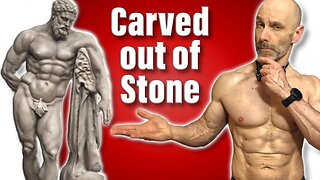Premium Only Content

Healthiest Weight and Body Fat For Men Over 50 (Does Age Even Matter)
Healthiest weight and body fat for men over 50 (does age even matter)
Today we’re going to look at the ideal weight and body fat percentage for optimal health over 50. The range is actually quite large. But we are going to take a realistic look at this range and narrow it down.
We are going to start with BMI, which stands for body mass index. To figure this out, you will need your height and weight. No one number is going to give us a complete picture of health. But this is a good place to start.
It’s important to note that if you are under 20 years old, you need a different BMI calculator than those of us that are older. I will put the calculator I’m using in the description so you can try it out for yourself.
A healthy BMI is considered between 18.5 and 24.9. To give you a practical example, I'm 5 foot 9 inches tall, so a healthy weight for me based on BMI is between 125 and 169 pounds.
https://www.cdc.gov/healthyweight/assessing/bmi/adult_bmi/english_bmi_calculator/bmi_calculator.html
https://www.calculators.org/health/ffmi.php
If you are interested in losing body fat and adding muscle, please email me at 1shark1bite@gmail.com for information on my personal training services.
Check your testosterone levels from home. Just click this link http://trylgc.com/laurence and receive 20% off with code: LAURENCE20 I receive commissions on referrals to LetsGetChecked. I only recommend services I know and trust.
My Affiliate link to Lebert for their Equalizer bars and more; https://lebertfitness.com/?ref=FitAnd50 and use the discount code FITAND50 you will receive 20% off your purchase
Facebook; https://www.facebook.com/Fit-and-50-5...
My Amazon page link; https://www.amazon.com/shop/fitand50
125 pounds! Maybe that’s healthy, but certainly, that’s not optimal. One pound less puts you underweight. So I think we could easily bump that up to 135 pounds, even if you have a very slight frame. If you have a larger bone structure, it would be even higher.
Clearly, there are flaws with BMI, which is why we look at other metrics to get a more accurate idea of health. To be fair, a BMI of 22 is considered to be the best, which in my case would be 149 pounds and for anyone who is underweight, that’s a good goal.
At the top end we have a BMI of 169 lbs. If I weighed this, I would be at about 17% body fat. This isn’t a bad weight and body fat percentage. I wouldn’t have visible abs, and most guys my height need to under 169 pounds to see their abs.
Still being 169 or 170 pounds and 17% body fat is a good weight loss goal if you were my height. Especially if you have never been that lean before, if you want visible abs, you will have to get under 15%. For context, I’m around 12 percent body fat right now.
The next question that comes to mind is can you have a healthy weight and body fat percentage that’s higher than this?
I checked to see what was the biggest a guy could get at my height naturally with premium genetics. To do this, I used a fat-free mass index calculator, which is abbreviated as ffmi. Fat-free mass is our body weight less the fat. And the index calculator measures this mass in relation to our height.
It ends up being 197 pounds with a body fat of 15%.
Now back to BMI, they have 169 pounds being borderline overweight, which could be possible. Depending on how much muscle mass you are carrying. This is why looking at our body fat percentage is essential.
The range that’s considered a healthy body fat percentage is quite large and higher than 17%. The first two health measurements you should be looking at don’t involve callipers or a DEXA scan. You just need a measuring tape.
How we carry our weight is an indication of health too. As guys, we tend to have more fat on our bellies and when we measure our waist if it’s 37 inches or more, we are at an increased health risk. If it’s over 40, this risk becomes even greater, potentially causing obesity-related problems like high blood pressure, high cholesterol, diabetes, stroke and heart disease.
While we are losing these inches, we should be resistance training to increase our lean body mass, and if we are doing this, it makes us different than the general population.
There are a couple of body fat charts used to determine a healthy fat percentage.
The Johnson and Pollock chart is considered the gold standard and makes allowances for ageing, stating that if you are between 51 and 55, your ideal body fat is between 18 and just over 23 percent, and if you're over 55, it’s around 20 to 25 percent.
25 percent body fat is considered obese.
This brings me to the American Council On Exercise’s chart, which doesn’t differentiate for age, but fitness level. Having athletes in the 6 to 13% range. This is pretty low for most people and especially when you add life enjoyment into the equation.
Your target body fat range would be more in line what the American Council calls the fitness zone of 14 to 17% body fat.
-
 4:47
4:47
Fit and 50
1 year ago $0.04 earnedThe Best Way to Choose Exercises for Muscle Growth (Greek god Physique)
6172 -
 LIVE
LIVE
LarryDickmanGaming
10 hours agoSNIKT Me Outside, How 'Bout Dat
22 watching -
 5:00:40
5:00:40
Captainpapsgaming
5 hours agoThe Thrilling Conclusion of Doom The Dark Ages! Come Hang!
1.06K -
 11:49
11:49
Nikko Ortiz
1 day agoCrazy Instant Karma Clips
73.8K34 -
 LIVE
LIVE
MSFT__kiLRoy
4 hours agoBorderlands 3 - Atlas Zane (Pt. 17) \\ Guardian Takedown Again...
292 watching -
 LIVE
LIVE
EXPBLESS
3 hours agoWhy Am I Awake This Early - Hunt Showdown Madness #RumbleGaming
59 watching -
 6:47:14
6:47:14
GamersErr0r
9 hours ago $0.66 earnedBecoming A Support Main | Marvel Rivals
7.47K -
 LIVE
LIVE
Lofi Girl
2 years agoSynthwave Radio 🌌 - beats to chill/game to
416 watching -
 20:14
20:14
GritsGG
17 hours agoHackers vs Win Squad! Let's Get it Done!
18.2K -
 59:26
59:26
Omar Elattar
9 months agoFrom HEROIN To CEO: How I Overcame Addiction & Built A $120k/Month Business
16.4K3